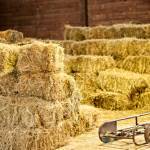Good-Quality Forage Important for Horses

During times when pasture is not available, such as after a drought or wildfire, the selection and purchase of hay or other forage sources becomes a vital decision for horse owners. The quality and nutrient content of the hay or forage source is critical because it is the foundation of the horse’s diet and provides 50 to 90% of the total nutrient intake for many horses.
Why should horse owners be concerned about forage sources for their horses? Due to the horse’s unique and delicate digestive system, it needs to consume a minimum of 1% of its body weight daily (dry matter) as forage in the form of hay, chaff, and pasture together with some grain.
Most horses are fed more than that amount, receiving 2% of their body weight per day in grass or hay alone. This means that a 450 kg (1,000 lb) horse will easily eat 5 to 7 kg (11 to 15 lb) of forage per day, along with 1.5 to 3 kg (3.3 to 6.6 lb) of a grain ration in order to maintain a healthy digestive system and good body condition. For lactating mares or young growing horses, hay consumption is much higher and can be as much as 3% of body weight.
When problems occur that may relate back to nutrition, people usually look at the grain ration. However, when the vast majority of the horse’s diet is hay or grass, we must pay more attention to the important role that hay or another forage plays in the horse’s nutritional status.
Several factors affect the quality, and therefore the nutrient content, of hay. These include plant species, fertilization, maturity at time of harvest, rain and sun when hay is harvested, climatic conditions, storage conditions, and age (time since cutting). The maturity of the plant at time of harvest determines the hay quality more than any other factor.
Legume hays such as lucerne (alfalfa) or clover have higher protein, energy, and calcium contents than grass or cereal hays. They are also usually more palatable and often a better value. Hay for horse consumption should be baled from grass that is in early maturity. The hay should have been allowed adequate curing time, and ideally was baled and stored without being rained on. If the hay was baled too green or was rained on, there will often be mold within the bale. This may be detected by smell or discoloration of stems. If hay gets wet after cutting, it can be dried to avoid mold, but often the stems are discolored and a lot of the sugar and energy are washed out of it. When certain types of mold are consumed by the horse, serious complications such as colic can arise.
After drying, some hay is very dusty. This is often more of a health risk than mold. Every time a horse buries its nose in dusty hay or picks up a piece and shakes it, there is a cloud of dust. Continuously breathing in dust at such close range will quickly lead to lung problems. The short term effect is acute pneumonia, with difficult breathing and coughing. The chronic effects are those seen with the condition of heaves or emphysema. This condition can be managed with medication, but never cured. If dusty hay is all you have, soaking the hay will keep the dust down but will also wash out some of the sugar and energy.
Most people buy hay based on how it looks, smells, and feels. These are qualitative factors, and they are important. When appraising hay, keep in mind the following points:
- It’s what’s inside that counts. Ask that one or several bales be opened so you can evaluate the hay inside the bales. Do not worry about slight discoloration on the outside, especially in stacked hay.
- Choose hay that is as fine-stemmed, green, leafy, and soft to the touch as possible.
- Avoid hay that is excessively bleached or discolored, or that smells moldy, musty, dusty, or fermented.
- Check for leaf loss. If the leaves of lucerne (alfalfa) or clover hay fall too easily off the stems, the horse won’t be able to eat them.
- Examine the leaves, stems, and flowers or seed pods to determine the level of maturity.
- Select hay that has been baled when the plants are in early bloom (for legumes) or preferably before seed heads have fully formed in grasses.
- Avoid hay that contains significant amounts of weeds, dirt, trash, or debris.
- Some cereal hays such as barley and triticale hay can have sharp awns if cut and baled when too mature.
- Examine hay for signs of insect infestation or disease. Be especially careful to check for insects in lucerne (alfalfa).
- Reject bales that seem excessively heavy for their size or feel warm to the touch. They may contain excess moisture that could cause mold or spontaneous combustion.
- When possible, feed hay within a year of harvest to guarantee the best nutritional value.
- Store hay in a dry, sheltered area, or cover the stack to protect it from the elements. Allow some air circulation when covering with plastic or tarps.
- Try to feed hay in a way that reduces wastage. Hay feeders or nets are very useful.
If hay isn’t available, you can feed high fiber feeds that contain a large percentage of chaff. Look at the crude fiber level as a guide.
Remember that hay can make up a large part of the horse’s diet when pasture is limited or nonexistent. If you are working your horses, they will usually need some added grain. Key visual and physical inspection factors include a fresh, clean smell and freedom from dust or mold. If in doubt about the quality of hay, don’t feed it!








